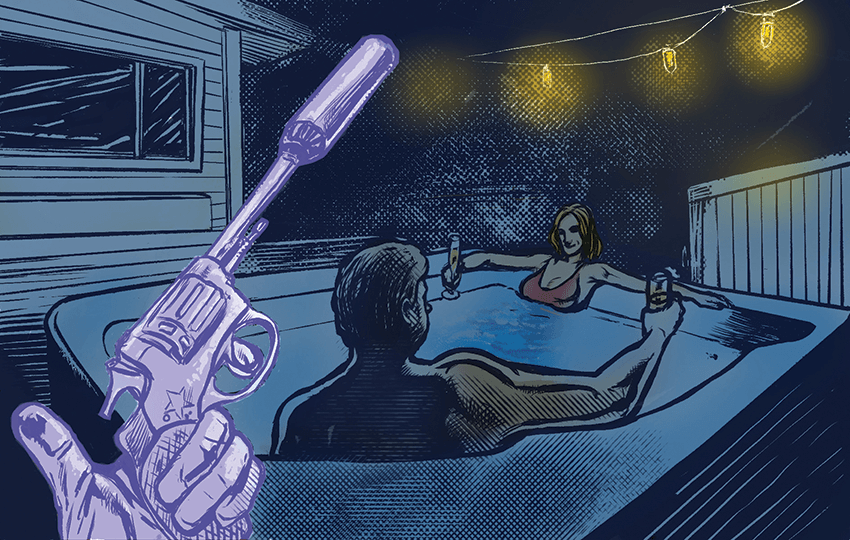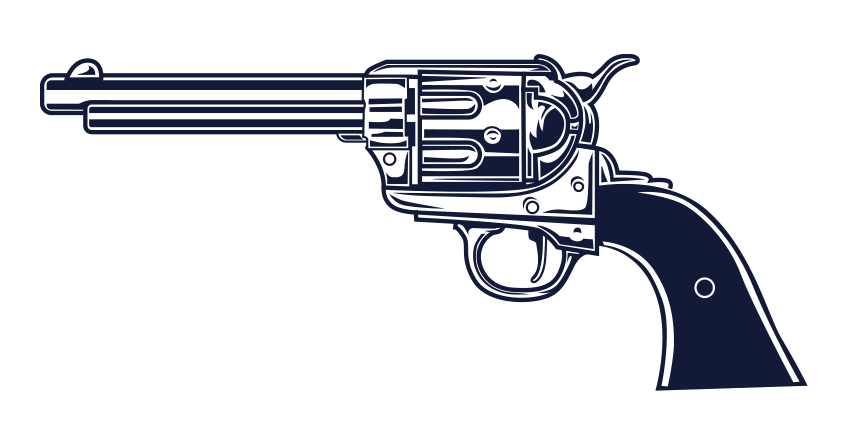The Buyback
JJ didn't want to part with his old revolver but figured it was better off with the authorities

Jordan Jasper — JJ to his few good friends — took one final look at the old seven-shot revolver in his own old hands. Its worn, bare steel was pitted and rusted in spots, its wooden grip panels smooth from being handled for more than a century, a few dings in the wood grain from God knows what. A faded metal stamping on the left side of the frame read:
L. NAGANT
BREVETE
LIÉGE
1898
In his younger days Jordan had taken high school and college French, so he thought the word in the second line — meaning “patented” — should have an acute accent on the final e and that the accent on the middle letter of the name of the Belgian city in the third line should be a grave accent and not an acute accent. Maybe the anomalies were some kind of Walloon thing.
He had bought the gun for cash at an antique store and didn’t have to go through all the rigmarole ordinarily involved in gun purchases; firearms manufactured in 1898 and before were considered antiques that didn’t have to be sold through federally licensed firearms dealers. Léon Nagant had come out with this model in 1895, and the Russians later bought the rights to it and produced the very same model up into the early 1950s. Jordan hated to give up a gun that had that much history behind it and was still in good working order to boot; he had test-fired it right after purchasing it.
He opened the trunk of his car, laid the unloaded gun on the carpeting, and closed the trunk. As he drove to his destination, he saw a queue of vehicles lined up in the right lane to make a right turn into what appeared to be some kind of paved lot, and he pulled in behind the last vehicle. As the vehicles snaked closer to the right turn, he saw the sign: GUN BUYBACK, with a big arrowhead pointing to the right. After making the turn, he saw a long table with an awning set up over it and a small dumpster beyond that; uniformed police officers were running the show.
Seeing an attractive young female officer approaching, Jordan rolled his window down. “Pop your trunk, sir.” She got the gun, closed the trunk, and took the gun to a white-haired male officer sitting at the table. After making sure it was unloaded, he cocked the hammer with his thumb and then pulled the trigger to make sure it was in working order; they didn’t take guns that didn’t work. He laid the gun aside, made a tally mark on a sheet of paper in a column designated for revolvers, and handed her something from a little tray on the table. She hustled back to Jordan’s rolled-down window. “Your hundred-dollar gift card, sir.” Before he could thank her, she had disappeared to the vehicle behind his; they probably wanted to keep things moving along because they would be closing for the day pretty soon. As he drove away, he saw a young male officer amble by the table, pluck up the revolver, and toss it into the dumpster. On his way home, he dropped by his favorite watering hole, The Shamrock, and treated himself to a few drinks with his gift card.
As Jordan watched the evening news the following day, there was a report about a double murder not too far from where he lived; 1900 BLOCK OF BLOSSOM STREET appeared at the bottom of the television screen during the on-location segment of the report. A couple had been shot to death in their backyard patio hot tub, their deaths coming to the attention of the authorities only after a drone video of their bobbing bodies had been posted online by one Jaquarious Jefferson, who just happened to have a warrant out on him for a weapons charge. Had Jaquarious by pure chance happened to fly his drone over what turned out to be a murder scene, or was Jaquarious stupidly showing off his own deadly handiwork, queried the news analyst. Just a couple of weeks earlier a couple of idiots who had broken into an ATM and gotten away with all the cash were captured after they posted cellphone photos of their exploits on social media.
Although Jaquarious was the prime suspect, a doorbell camera had picked up two separate instances of a different person each time who, after ringing the doorbell and not having anyone answer, walked around toward the back of the house where the hot tub was. Homicide Detective Steve Clappart stated that those individuals were persons of interest; a phone number to be called should anyone have relevant information appeared at the bottom of the television screen. Detective Clappart also went on to say that because the bodies had been in heated water for an undetermined amount of time, it was not possible to pin down the time of death. The report ended with a mention of the ongoing gun buyback program, whose purpose was to get guns off the streets and prevent murders like the double homicide currently being investigated; a brief snippet of footage showed the same easy-on-the-eyes female officer who had collected Jordan’s own gun now taking a single-shot, break-action shotgun out of the trunk of a vehicle driven by another buyback participant. The next report up involved the groundbreaking ceremony at the location for the new police department headquarters.
* * *
The following day, the evening news ran a story about the capture of Jaquarious along with a small arsenal of stolen weapons. There was also a brief piece about social media posters exulting over the death of the couple found in the hot tub; apparently the couple had done a lot of people wrong, and those wronged were happy the couple was no longer among the living. In fact, there was even a party being planned in celebration of their demise. Back at the old police department headquarters, Detective Clappart anxiously awaited the crime lab’s report on the slugs recovered from the couple’s bodies. The department’s ShotSpotter system had not detected any gunfire in that area, and interviewed neighbors reported not hearing any gunshots, so Clappart thought it had to be a silencer job — and one of the guns from Jaquarious’ cache was a silenced 9 mm semiauto. If the slugs matched, the case would be a slam dunk.
Clappart was dumbfounded when the crime lab report identified the slugs as 7.62 mm Nagant manufactured by Fiocchi, full metal jacket with a bullet weight of 98 grains. But it confirmed his view that the double murder was a silencer job: The Nagant revolver, because of its special design, allowed none of the noisy gunpowder blast to escape between the cylinder and the barrel like conventional revolvers did; instead, all the blast went out through the muzzle, where it could be funneled into a silencer. There were no marks on the bullets indicating contact with silencer components, so the silencer must have been a precisely machined device that lined up with the bore axis of the gun just right, allowing just the right amount of clearance for the bullet to pass without touching anything.
He immediately called his ATF contact, explained his case, and asked if a database search could be initiated for individuals who had both purchased a Nagant revolver and had also purchased a silencer or been given ATF permission to build one. He kept his fingers crossed that the murder weapon hadn’t been stolen; but if it had been legally purchased before having been stolen, there should be an active theft case open that could lead to the thief. When he finally received the file from the ATF and opened it on his computer, he was surprised at how many hits there were that matched his criteria. There were three right there in the city, not that unusual because the city had a licensed silencer dealer and numerous venues that sold guns. The match closest to the scene of the crime was one Jordan Jasper.

Although Jordan’s name had come back squeaky clean when it had been run through the system, Clappart took no chances and had plenty of backup when he delivered the search warrant to Jordan’s residence for the Nagant revolver. Jordan had excitedly acknowledged that he knew Detective Clappart from seeing him on television and frankly asked if they thought his gun had been used in a crime. Clappart replied that there were several Nagant revolvers in the city that were going to be test-fired for bullet comparison in relation to an ongoing investigation. Jordan turned over the gun without ado, assuring Clappart he would find it hadn’t been used in whatever crime was being investigated. The weapon was exactly the same design as the Belgian Nagant, but it was blued and in mint condition, had checkered Bakelite grip panels, and was Soviet army surplus vintage 1938; its serial number matched that on the ATF paperwork. But Clappart noticed something amiss, and he casually broached the subject: “I’ve read that there’s kind of a fad with these guns, people having the end of the barrel threaded to take a silencer. You not into that?”
Jordan took the bait. “Didn’t want to mess up the end of the barrel on a fine collector’s item like this. Got a twist-on adapter that uses the front sight as a locking lug to hold it in place. Seven-point-six-two silencer screws onto the threaded end of the adapter. The Russians used silencers that directly attached the same way in the Second World War.”
“Hadn’t heard about the adapter, but it makes perfectly good sense.” Clappart paused before he went on. “You know, you don’t have to talk to us, but it would help us out tremendously if you could tell us whether you were anywhere near the 1900 block of Blossom Street this past Monday or Tuesday.” Clappart wanted to see whether Jordan would volunteer some plausible-sounding alibi or whether he would clam up.
Jordan’s eyes widened. “That double murder in the hot tub! Someone popped ’em with a Nagant?”
“Sorry, but we’re not at liberty to divulge anything about that case.”
“I figured. Well, let me go ahead and incriminate myself before someone else does. You’ve got the houses along the south side of Blossom Street, and right behind the backyards of those houses you’ve got that brushy ridge that rises up and runs parallel to Blossom Street. Got those high-tension power line towers strung along the ridge. Well, there’s a hiking trail that runs along the top of the ridge. If you pull up the satellite view on Google Maps, you can actually see the trail. Anyway, I often go on long walks on that trail. Took one on Monday, mid or late afternoon. I’m retired, so I don’t look at my watch as often anymore. Got back home, puttered around a little, drove to my favorite watering hole, The Shamrock, had a few drinks, drove back home, and didn’t go anywhere else. Security cameras from The Shamrock would show exactly when I arrived and when I left. Like I said, I don’t look at my watch nearly as much now that I’m retired.”
“We appreciate your cooperation. And we’ll try not to keep your gun any longer than we have to.” Clappart had been so fixated on the doorbell camera video showing people approaching the residence from the front that he hadn’t even considered that someone could have approached from the rear down from the ridge — and the house was situated on the south side of Blossom Street, its hot tub deck in the backyard, the backyard extending right to the base of the ridge. It was a shame the couple didn’t have a security camera covering their backyard; the neighbors on either side didn’t have security cameras covering theirs either. He didn’t quite know what to make of Jordan’s candid narrative.
Clappart was on pins and needles waiting to hear something from the ballistics division of the crime lab and went into a funk when they told him the slugs fired from Jordan’s gun didn’t match those taken from the bodies — not even close. Now he’d have to check out the other two Nagants in town and follow up on trying to find out who the people were in the doorbell camera footage. He’d also have to start interviewing those who heartily approved of the couple’s murder on social media because the couple had wronged them; but then again, the murderer might not have been one of those actually wronged but rather a sympathetic vigilante anonymously acting on their behalf. You just never knew in homicide.
* * *
That afternoon Jordan was at his favorite perch in The Shamrock, watching the news on one of the flat-screen televisions and treating himself to more drinks with his gift card; a follow-up story on the groundbreaking at the site of the new police department headquarters was just winding up. Several tables had been put together end to end behind him to make one long table that sported a RESERVED sign; people had begun seating themselves at the table and sharing uncomplimentary gossip about the murdered couple. Another segment on the gun buyback came on, this one dealing with what was going to happen to the guns once they had been collected. “They’re disabled by this machine here,” said the petite Latina reporter, fanning her arm out toward a horizontal hydraulic press. The head of the ram on the press was shaped like a blunt right angle, and so was the raised backstop at the end of the press table. Whatever was placed across the table in front of the backstop was bent into a rough right angle when the ram pressed it against the backstop.
The next firearm up for abuse was a dull, silvery revolver whose features were partially obscured first by the press operator’s hand as he picked it up and then by the apparatus after the gun had been placed upside down in the narrow gap between the ram and the backstop. Probably no one else watching would have been able to identify the make and model of the gun from what briefly appeared on the screen, but Jordan knew exactly what it was. He winced as the fine old piece was irreversibly mutilated, its barrel now bent sideways away from the frame.
It was then unceremoniously chunked into a dumpster with the other disabled firearms. The camera then cut back to the reporter: “The disabled guns are going to be melted down and made into reinforcing bar — rebar — that goes into poured concrete structures to strengthen them. The batch of rebar made from the bought-back guns is going to be set aside to be the first rebar to be used in the construction of the new police headquarters building —”
The people at the long table looked over at the sniggering old man seated near them, wondering what he had found so funny.

